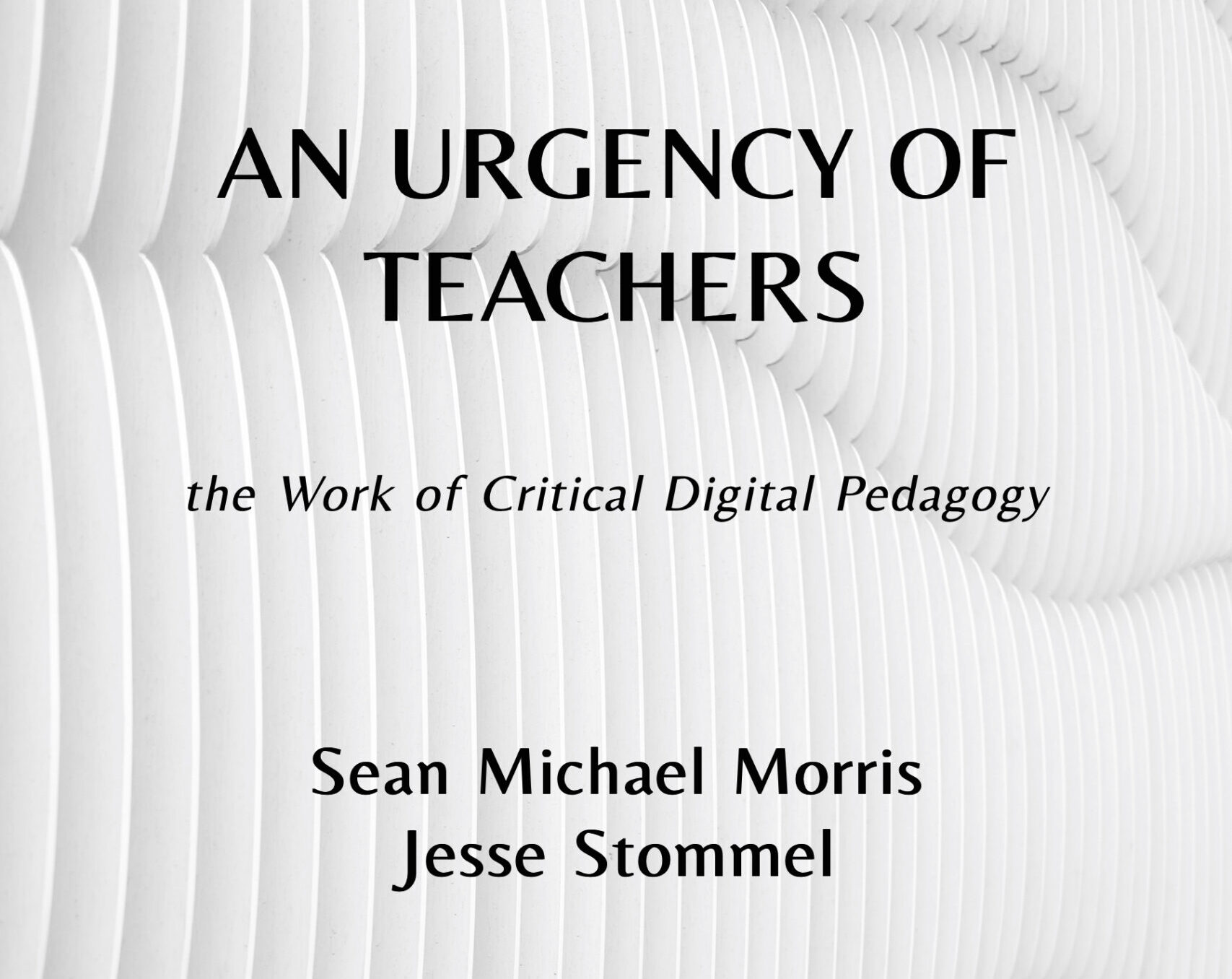An Urgency of Teachers: The Work of Critical Digital Pedagogy
Three Ideas
Intro
Like many of you, our last few months were jam-packed with learning new teaching tools, attending webinars, and designing online courses. It was and is still a time of societal and educational crisis that demands learning on-the-go. We are appreciative of the leap of faith that KPU faculty and administrators took in order to shift online and keep our commitment to our students. Three months later, it now seems that the crisis has passed its initial peak and we finally feel that we can spend some time beyond the immediate to consider the wider challenges and possibilities in moving online.
This is particularly important as it becomes more and more likely that we will stay online in the next academic year. As ardent face-to-face educators, we both had some work to do on reconceptualizing online learning. Time to eat your brussels sprouts (and you better learn to like them because we’re going to be eating them for dinner a lot more). Dang.
There was a pitch for a book club through Twitter to read An Urgency of Teachers: Critical Digital Pedagogy. We both jumped in and in short order found the humanity and joy we both feared was vanishing before our very eyes in this weird, difficult, detached COVID period. We believe that this book, in which we found a home for both our concerns and our hopes, can be instrumental in conceptualizing online learning, and in inviting critical gaze into our practice. In this blog post, we want to share three main ideas from the first two chapters of the book and discuss the ways they may impact teaching practices at KPU. Like we said, it’s packed with ideas, reframes, realities, and promise. It’s a book to take your time with and savour, more like your favourite cheesecake after the brussels sprouts.
The Main Idea
Critical pedagogy is concerned with the philosophy and practice of teaching. It is predicated on fostering agency and empowering learners but also supporting interest in one another, hearing each others’ voices, and recognizing each others’ presence. Unlike a banking model of education preparing students for a life of subordinated labour, critical pedagogy aims to prepare students for a self-managed life (Freire, 1970/2000). Critical pedagogy challenges normative assumptions about knowledge, the roles of the teachers and students, and the hierarchies between them. It calls to create a participatory space that blends the divisions between the class and the world and the teacher and the students.
Critical digital pedagogy (CDP) applies these concepts in the digital domain, to examine ways of constructing (co-constructing) knowledge as part of (not in advance of) learning. CDP seeks to support agentic participation by building better tools rather than constraining selves and activity, caged in antiquated Learning Management Systems (LMS) models. According to the authors, Sean Michael Morris (@slamteacher) and Jesse Stommel (@jessifer) (follow them on Twitter), digital pedagogy is not a path; it is a compass. Many beginners in online teaching, us included, find solace in tools and prescriptions when we start to feel overwhelmed. For that reason, CDP is important as a conceptual frame that, like critical pedagogy, is not disconnected from life but translated to daily action and reflection.
We want to highlight three main themes that we see as a call to action, for all educators at this time:
- Start with Humans (Coded Boundaries & Solid Boundaries)
To start with humans is to start with meaning, something that exists within human subjectivity rather than a material plane (Atwood & Stolorow, 2014). As meaning makers, we dialogue, interpret, build mental models, make predictions, and scan, scan, scan our environments, ourselves, and each other. Is learning and, by proxy, pedagogy, meaning-making? We think so, and this is the lens through which we approached the book.
The entire enterprise of education is too often engaged in teaching that is not pedagogical. There are a whole host of other words we’d use to describe this work: instruction, classroom management, training, outcomes-driven, standards-based, content delivery. Pedagogy, on the other hand, starts with learning (i.e., meaning-making) as its centre, not students or teachers, and the work of pedagogues is necessarily political, subjective, and humane. In a physical classroom, there are lots of bounded spaces. Some are value neutral: doors, windows, chairs, whiteboard, fan, lights. Most are value laden: the seats where the shy student tries to be inconspicuous, and the seats up front for the “keeners” or the visually impaired; the instructor standing at the front of the class (I am an expert), the instructor seated amongst the students (I am flattening the hierarchy). Whatever the case, we come to learn both the value-neutrality and value-ladenness through experience, an appropriation of cultural tools (Vygotsky, 1978).
What about when we teach online? Where are our walls and chairs and podium in digital space? Where are the values and how are they communicated? We can’t see them, so now what? For some, the coded boundaries of the LMS replace the solid borders of the classroom, and discussion forums become the arrangement of chairs. Video lectures have been used to replicate an instructor’s presence on the screen, and quizzes with algorithmically automated teacherly responses offer feedback in lieu of written notes and gold stars.
CDP invites us to think critically about where the walls are and where our teaching territory lies. Design courses so that teaching territory is determined by pedagogical intention rather than the tools. It invites us to explore how we can create a shared communal space within the wider open space of the internet, in a way that blends the outside and the inside (the world and the word). It challenges us to be present and engaged in our online courses, while being attuned to those on the margins of the online space (the quiet auditors, the ones who don’t submit assignments, and the ones you just never hear back from).
- Multiple Epistemologies (Learning Doesn’t Require Accuracy)
First things first: What is epistemology? Epistemology is the philosophy of knowledge. What do we know? How do we know it? What counts as evidence? How can we know that our claims are justified and valid? Critical digital pedagogy asks that we take into account that there are differing epistemologies and that we integrate multiple ways of knowing into our pedagogy.
Critical theorists argue that both pedagogy and knowledge formation are not ideologically neutral and this has profound implications for our epistemological commitments. It means that we have to unpack our underlying assumptions about what is counted as a valid knowledge and why (e.g., what history text do we use) and what assumptions are embedded in our pedagogical choices (e.g., what are we testing when giving a test). Our work has wondered at the extent to which Critical Pedagogy translates into digital space. Can the necessary reflective/constructive dialogue flourish within Web-based tools, within social media platforms, within learning management systems? How can we build platforms that support learning and meaning-making across age, race, culture, ability, and geography?
One of the problems with learning management system gradebooks, often mapped to rubrics and outcomes (which have run equally rampant of late), is that they assume students (and their experiences) are interchangeable. And they assume the same of teachers. The problem (recall the earlier point about meaning-making and humanness) is that lesson plans and assignments can’t be expected to work exactly the same with every set of students, with every teacher, or on every given day. Furthermore, assignments are contextualized and constructed differently between students and that is a feature of the epistemological commitments that both us, the teachers, and our students bring to the table.
At KPU we have the privilege of an extremely diverse student body. Our students, from different countries and with different backgrounds, languages, experiences, tragedies, and joys have diverse ways to engage and participate in our classes: for some talking in class is easy (sometimes too easy) while others are shy to participate in front of a whole class, or are uncomfortable to disagree with a teacher. This diversity is underlined by individual differences (each student is unique), as well as by shared threats grounded in the student’s background and positionality. We must ask how this diversity, that is much more recognizable in face-to-face classes, operating in online courses? Further, how can digital pedagogy function to frame diversity in terms of richness of meaning and strength in opportunity?
Both teachers and learners must approach the classroom from a place of meaning construction, flexibility, and building. Both must be willing to see the encounters, exchanges, interactions, and relationships that develop in a classroom as a dynamic ecology. Grades, and the (very bizarre) notion of their systematized objectivity, stand as an immediate affront to this kind of classroom. As teachers (the authority figures) we have a bigger part in creating dialogic spaces by inviting our students to co-create with us. For many students much of their schooling experience was the opposite, so they might need time, encouragement, and the development of direct lines of meaningfulness to immerse themselves in such learning (join Teaching & Learning workshops on intercultural course design and assessment if you want to learn more).
- Policing vs. Learning
Imagine a person swimming leisurely in the ocean, while another person swimming next to them is frantically swimming trying to escape a shark. Both people are swimming, but their meaning, motivation and execution are very different. Similarly, in education we can use different methods to try to reach our goals. While the results might look similar, the why and how makes all the difference.
For example, it seems that in recent years there has been an increase in policing at KPU. This increase is often attributed to an increase in cases of plagiarism, that in turn is attributed to an increase in international students. While by no means we downplay the importance of eliminating plagiarism (that might be even more prevalent in online courses), we argue that it is important to explore the reasons beyond the increase in plagiarism and to try to understand the root causes rather than deal with the symptoms.Whenever there is an increase in policing in society in general, it is usually a sign of an underlying societal injustice. Similarly in education, when there is an increase in policing it might be an indication of lack of engagement in learning (by both students and teachers) and a disconnect between the university experience and the lived-experiences of our students. We can try to prevent plagiarism with more and more complex systems of policing and monitoring, but it will never solve the problem unless we engage our students in deep learning, with fewer high stakes assessments, authenticity of learning activities, and connectedness to themselves, their instructors, and each other.
In this sense online teaching actually creates a promise; while F2F teaching is underlined by the historic and contemporary structures of university, and marked by many forms of discrimination (e.g., in admission, forms of knowledge valued, and assessment), online learning to most people is a newer, less “traditional” phenomena. It has the potential to be less structured and canonized, opening more spaces for engagement in our courses rather than focus on policing and supervision. It is also a space in which some of our students, who in most cases belong to younger more tech savvy generations, could take the lead if we invite them to do so.
However, as Morris and Stommel argue, to create deep learning we must acknowledge that in critical digital pedagogy, the space of learning is more fluid and adaptable than we might have planned on. They urge us to “…create more collaborative and less hierarchical institutions for learning — lest we use computers to replicate the vestigial structures of industrial-era education (436).” Hence, CDP asks that we return to the humanist roots of meaning-making rather than the tightly surveilled measurement of historical canons, habits of mind, and the sticky, persistent notion of the human bathtub waiting to be filled with knowledge.
Concluding thoughts
CDP is about unlearning as much as it is about learning. It’s an invitation to forget some of the structures that underlie schooling in order to create more liberating spaces. This is a call to action to us as teachers to unlearn some of the hierarchies and structures and imagine new possibilities. This is not an easy thing to do. Like all attempts to practice critical pedagogy, it is always an utopian and unfinished business. But it offers a promise to ourselves as educators, and to our students, to create spaces of hope, dynamism, and dialogue. If learning means construction, then learning is never done, because meaning-making is an ongoing, elaborative, integrative process. It does not have a terminus, a perfection. There is no 100% because the contextual web in which learning occurs is infinite. An Urgency of Teachers pushes us to develop critically voracious learning communities where students depend on each other as much as the instructor to play, experiment, and learn. Atwood, G.E., & Stolorow, R.D. (2014). Structures of Subjectivity: Explorations in Psychoanalytic Phenomenology and Contextualism (2nd ed.). London: Routledge.
Freire, P. (1970/2000). Pedagogy of the Oppressed. New York: Bloomsbury.
Morris, S.M., & Stommel, J. (2018) An urgency of teachers: The work of critical digital pedagogy. Hybrid Pedagogy Inc.
Vygotsky, L.S. (1978). Mind in society: The development of higher psychological processes. Cambridge: Harvard University Press.


